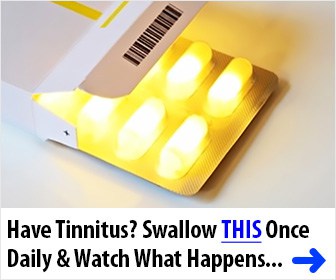An unknown tinnitus culprit, salt can be a major factor in helping to control the ringing in your ears.
This handy guide will give you the facts about salt, how it’s affecting your tinnitus and easy ways to cut it down starting today.
90% of Americans are getting too much salt in their diet.
On average, we’re eating 2.5x more than we should be.
Did you know that 65% of the salt you’re getting in your diet is from pre-made food you buy at the grocery store?
An additional 25% of your extra salt intake is from restaurants and takeout.
When you make your meals at home and add salt yourself, that only adds up to 10% of the salt you’re eating.
All this extra salt adds up over time leading many of us to suffer from high blood pressure, heart disease and stroke.
What many people don’t realize is that salt can worsen your tinnitus.
Basically, whenever you eat any salt, it raises your blood pressure which makes your blood flow fast all throughout your body.
Which also makes it flow faster to your ears.
With more blood flow in your ears, the ringing and buzzing can get worse because there’s more activity there.
To help you curb your tinnitus, here are 8 simple ways you can cut back your salt intake.
Bonus: You’ll be making healthier life choices at the same time.
1. Watch for hidden sodium
The top sources of hidden sodium according to the American Heart Association are:
- Bread and Rolls
- Pizza
- Sandwiches
- Cold Cuts and Cured Meats
- Soup
- Burritos and Tacos
- Frozen meals
- Sodas
It may not taste salty, but the salt is there.
Other places that this may be lurking include prescription and over-the-counter medications.
Soda can be a double whammy for the ringing in your ears, since it has salt as well as sugar, which also irritates tinnitus.
You can find the facts here as well as some easy switches you can make to lessen your sugar intake.
2. Read labels

Read labels and nutrition facts carefully.
The easiest way to do this is to check out how much of your daily percentage you’re getting with that product.
Look for 5% or less in the daily value of sodium per serving.
Another trick is to look for labels with the American Heart Association’s Heart-Check Certification.
3. Substitute spices
Put down the salt shaker and pick up herbs and spices to add flavor to your meals.
Squeeze fresh lemon or lime juice and add pepper and fresh veggies to your recipes.
Mixing vinegar and lemon gives the same type of sensory effect as salt.
Other things you can try to use are:
- Mint
- Rosemary
- Cinnamon
- Sage
- Parsley
- Fresh dill
- Nutmeg
- Ginger
4. Limit how often you eat out

Although the worst offenders are fast-food and takeout places, even dine-in restaurants have a lot of salt in their food.
Some restaurants have heart-check symbols on their menus to help guide you.
Or you can simply ask your server what ingredients are used to help you make the best choices for you.
Remember that most of the salt is hidden in the broths, sauces and processed ingredients.
So, you can do your own detective work by reading the menu avoiding a dish that seems sauce or gravy heavy.
5. Choose fresh over processed
Canned soups and frozen meals are high in sodium.
Some meals have as much as 2000 mg packed in those little meals.
Shockingly, the recommended daily intake is only 1500 mg.
Try making meals and freezing them, if you find yourself short on time to prepare lunch or dinner through the week.
Choosing one day per week, or even just once or twice a month, where you prepare a few big meals to batch and freeze will go a long way.
You get to add in more healthy ingredients and avoid the less nutritious ones.
As a bonus, you’ll find that making meals yourself is a great way to save on your monthly budget.
6. Choose healthy snacks

A lot of snacks like pretzels, chips, nuts are full of sodium.
Cheese is packed with it along with pickles, and deli meat or cold cuts.
Next time you do your groceries you can easily switch out your favorite snacks with a lower-sodium option.
Another idea is to slice up some fruits and veggies and store them in a Ziploc bag in the fridge for a quick and easy snack.
7. Be careful when using condiments, dressing, and sauces
Soy sauce, ketchup, bottled dressings, dips, salsa in a jar, all are high in sodium.
Use them sparingly or look for condiments and sauces that have reduced salt.
These days, the low-sodium versions of many foods are easily accessible.
8. Cook at home, from scratch

When you make home-cooked meals from scratch you know exactly what ingredients you are using.
Use pepper, citrus and vinegar as a substitute for flavor.
Avoid cooking packaged meals and try for fresh veggies over canned.
If you use frozen veggies, read the labels carefully to check the amount of sodium in the package.
Conclusion
Discovering the many places that salt is hiding can seem overwhelming.
But if you’re willing to try a few simple steps like practicing reading nutrition labels, you’ll go a long way in painlessly cutting down your salt intake.
Figuring out what seems to irritate the ringing in your ears can take a lot of trial and error.
If you decide to try cutting down salt to see if this is a culprit for you, make sure you do it for at least two-weeks to get a really clear picture on how it affects you.
You can also take a look at foods that irritate tinnitus to see if one of those are making your tinnitus worse.
There are some proven tinnitus treatments, as well as new breakthrough tinnitus cures being worked on right now.
In the meantime, you can take back control of your life by learning ways to get better sleep when you have tinnitus and how to deal with anxiety and tinnitus.








